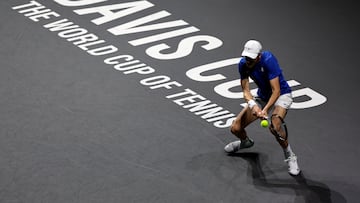What format changes are coming to the Davis Cup in 2025?
The next edition of the tournament will have seven qualifying rounds prior to the Final Eight, which will replace the group stage.

The Davis Cup will change format in 2025, with seven qualifying rounds leading up to the Final Eight replacing the current group stage, the International Tennis Federation (ITF) announced on Friday. The Billie Jean King Cup (BJKC), formerly the Fed Cup, will also undergo changes to its format, with the final phase reduced from 12 to eight teams next year, in a step towards assimilating both competitions in the future.
Felix yesterday 🥶#DavisCup ┃ @felixtennis https://t.co/mcQYhu31k5 pic.twitter.com/xX70MHmkPy
— Davis Cup (@DavisCup) September 16, 2024
Davis Cup group stage abolished
The 2025 Davis Cup will see the elimination of the group stage, which was previously played across four venues over six rounds in September, and will be replaced by seven two-day ties, with two singles matches in the first round and two singles and a doubles round in the second. The final will be played either home or away, depending on the teams in each round. The seven winning teams from these September ties (there will have been a first round of 13 ties in January) will join the host team in the Final on 8 November.
The change will “facilitate the players’ schedule immediately following the US Open, while maintaining the intensity of a competition that all players love,” said ITF President David Haggerty. The new format will also “allow us to showcase world-class tennis in more countries around the world and increase awareness and participation.”
Introducing a new Davis Cup format for 2025 🥁
— Davis Cup (@DavisCup) October 4, 2024
A thread starting with the first round of Qualifiers ⬇️#DavisCup pic.twitter.com/rVnfTV5ZYs
Seven group stages with three teams per group
At the BJKC, the Final 8 will be reached through seven group stages in April, with three teams per group playing each other. There will be two singles matches and one doubles match in each encounter. The seven winning teams will join the host team in the final. This is a transitional system to balance the number of eight finalist teams.
But from 2026, qualifiers will also be adopted from that stage in April. ”The change to an eight-team final aligns with the Davis Cup Final 8 format, which has proven to be very successful,” Haggerty said of the new BJKC.
Related stories
Bidding processes for the Davis Cup and BJKC finals are underway, the ITF said, although to host and therefore guarantee a presence at the respective finals a country must be ranked in the top 50 or have at least one player in the top 10. If not, the host invitation will be granted to another team. The finals of both competitions will be held this year in Málaga, Spain on dates that partially overlap: from 13 to 20 November for the women’s competition and from 19 to 24 November for the men’s.
Both tournaments, which are defined as the World Cup of tennis, have changed format several times in recent years, in search of a satisfactory solution for both players and the public. The former had generally shown themselves to be in favour of bringing back the two-legged qualifiers that would give them the chance to play in front of their home fans. In this edition, the teams from the United States, Germany, Chile and Slovakia played for a place in the Final 8 in Zhuhai, China, where there was no local team.


Complete your personal details to comment